NCLEX Final Exam Questions & Answers (Real Exam) 2023
Document Content and Description Below
NCLEX Final Exam Questions & Answers (Real Exam)-Which of the following risk factors for coronary artery disease cannot be corrected? a. smoking b. hypertension c. genetics d. diet - c. genetics ... Which of the following actions is the first priority care for a client exhibiting signs and symptoms of coronary artery disease? a. decrease anxiety b enhance myocardial oxygenation c. administer sublingual nitroglycerin d. educate the client about his symptoms - b. enhance myocardial oxygenation Which of the following is the most common symptom of myocardial infarction? a. chest pain b. dyspnea c. edema d. palpitations - a. chest pain Which of the following landmarks is the correct one for auscultating an apical pulse? a. left second intercostal space, midaxillary line b. left fifth intercostal space, midclavicular line c. left third intercostal space, sternal border d. left fourth intercostal space, midclavicular line - b. left fifth intercostal space, midclavicular line Which of the following systems is the most likely origin of pain when the client describes a knifelike chest pain that increases in intensity with inspiration? a. cardiac b. gastrointestinal c. muskuloskeletal d. pulmonary - d. pulmonary A murmur is heard at the second left intercostal space along the sternal border. Which valve area is this? a. aortic b. pulmonic c. mitral d. tricuspid - b. pulmonic Which of the following blood tests is most indicative of cardiac damage? a. lactate dehydrogenase b. complete blood count c. troponin d. creatine kinase - c. troponin What is the primary reason for administering morphine to a client with myocardial infarction? a. to sedate the client b. to decrease the client's pain c. to decrease the client's anxiety d. to decrease oxygen demand on the client's heart - d. to decrease oxygen demand on the client's heart After an anterior wall myocardial infarction, which of the following problems is indicated by auscultation of crackles in the lungs? a. left-sided heart failure b. pulmonic valve malfunction c. right-sided heart failure d. tricuspid valve malfunction - a. left-sided heart failure What is the first intervention for a client experiencing a myocardial infarction? a. administer morphine b. administer oxygen c. administer sublingual nitroglycerin d. obtain an EKG - b. administer oxygen What is the most appropriate response to a client having a myocardial infarction who is fearful of dying? a. "tell me how you are feeling right now" b. "when the doctor arrives, everything will be fine" c. "this is a bad situation, but you will feel better soon" d. "please be assured we are doing everything we can to make you feel better" - a. "tell me how you are feeling right now" With which of the following disorders is jugular vein distention most prominent? a. abdominal aortic aneurysm b. heart failure c. myocardial infarction d. pneumothorax - b. heart failure Which of the following disorders would the nurse expect to assess sacral edema in a bedridden client? a. diabetes b. pulmonary emboli c. renal failure d. right-sided heart failure - d. right-sided heart failure Which of the following symptoms might a client with right-sided heart failure exhibit? a. adequate urine output b. polyuria c. oliguria d. polydipsia - c. oliguria Which of the following conditions is most closely associated with weight gain, nausea, and a decrease in urine output? a. angina pectoris b. cardiomyopathy c. left sided heart failure d. right sided heart failure - d. right sided heart failure A pulsating abdominal mass usually indicates which of the following conditions? a. abdominal aortic aneurysm b. enlarged spleen c. gastric distention d. gastritis - a. abdominal aortic aneurysm Which of the following complications is of greatest concern when caring for a preoperative abdominal aneurysm client? a. hypertension b. aneurysm rupture c. cardiac arrhythmias d. diminished pedal pulses - b. aneurysm rupture Which of the following groups of symptoms indicate a ruptured abdominal aneurysm? a. lower back pain, increased BP, decreased RBC, and increased WBC b. severe lower back pain, decreased BP, decreased RBC, and increased WBC c. severe lower back pain, decreased BP, decreased RBC, and decreased WBC d. intermittent lower back pain, decreased BP, decreased RBC, and increased WBC - b. severe lower back pain, decreased BP, decreased RBC, and increased WBC Which is the term used to describe an enlargement of the heart muscle? a. cardiomegaly b. cardiomyopathy c. myocarditis d. pericarditis - a. cardiomegaly A nurse checks a client's oxygen saturation by using a bedside sensory probe. The client has pneumonia that is currently being treated with antibiotics. When the nurse places the pulse oximeter probe on the client, the first reading shows 89%. Which of the following actions should the nurse take first? a. assess the probe site to ensure an accurate reading b. administer 100% oxygen and monitor the pulse ox until it reaches 95% c. raise the head of the bed and ask the client to take a deep breath d. contact the health care providor for a chest x-ray - a. assess the probe site to ensure an accurate reading Which best describes the purpose of pursed lip breathing in a client with COPD? a. to reduce the overall work of breathing b. to strengthen the muscles of the rib cage c. to balance the effects of carbon dioxide and oxygen in the bloodstream d. to exercise the muscles of the diaphragm - c. to balance the effects of carbon dioxide and oxygen in the bloodstream A client who is being treated for asthma needs to take the next dose of bronchodilator medication. After administering the drug, the nurse notes the unlicensed assistive personnel is passing out breakfast trays. Which of the following items on the breakfast tray should the nurse discuss with the client before the client consumes breakfast? a. grapefruit juice b. waffles c. coffee d. eggs - c. coffee The nurse is caring for a client with TB and is giving a report to the oncoming nurse. Which of the following statements is most appropriate? a. "the client screened positive for TB so I have stocked surgical masks outside the room" b. "the client is positive for TB and will require airborne precautions" c. "the client is positive for TB and will require enteric precautions" d. "since the client has started TB treatment, there are only 24 hours left for isolation" - b. "the client is positive for Tb and will require airborne precautions" A client is in need of an emergency tracheostomy. Which of the following scenarios does this involve? a. a tube is passed into the mouth and through the larynx b. a puncture is made through the cricothyroid cartilage c. a surgical incision is made into the trachea d. a tube is passed through the nose and into the trachea - c. a surgical incision is made into the trachea On auscultation, which finding suggests a right pneumothorax? a. bilateral inspiratory and expiratory crackles b. absence of breath sounds in the right thorax c. inspiratory and expiratory wheezes in the right thorax d. bilateral pleural friction rub - b. absence of breath sounds in the right thorax A client has a continuously running peripheral infusion. The physician orders an antibiotic as a piggyback infusion four times per day. In order to administer the antibiotic, the nurse should do which of the following? Select all that apply. 1. Avoid compatibility issues by starting an additional IV access. 2. Start a new IV access to eliminate the problem of too much volume for one site. 3. Flush the IV line before and after infusion of an incompatible drug. 4. Check to see if the antibiotic is compatible with the continuous infusion. 5. Change the flow rate to facilitate the administration of the antibiotic. - Answer: 3,4, 5 The family of a home infusion client calls the home health nurse one night to report that the electronic infusion pump is alarming. What should the nurse anticipate as the cause of the infusion pump alarming? Select all that apply. 1. The client's pulse and blood pressure are falling. 2. The client is experiencing a reaction to the medication. 3. The prescribed infusion is complete. 4. There is an incompatibility with the medications. 5. An occlusion has interrupted the infusion. - Answer 3, 5 The home health nurse is monitoring a client who performs self- care of a central line. The nurse observes the client doing all of the following activities. Which activity indicates the need for further education? 1. Flushing the central line with a 3 mL syringe 2. Cleaning the needleless injection cap with alcohol before accessing 3. Using sterile gloves to change the central line dressing 4. Wearing a mask while changing the central line dressing - Answer 1 The client has a tunneled Groshong catheter for intermittent medication administration. After administering the medication, the nurse prepares to do which of the following? 1. Clamp the catheter after medication administration. 2. Flush the catheter with heparin at scheduled times. 3. Flush the catheter with saline after medication administration. 4. Initiate a Valsalva maneuver when disconnecting medication tubing. - Answer 3 The client has a percutaneous jugular central venous line that is capped and used for intermittent infusions. After administering the medication, the best method to maintain patency is to do which of the following? 1. Flush the line first with 3- 5 mL of normal saline, then with 1- 3 mL of heparinized normal saline. 2. Flush the line with 3- 5 mL of normal saline. 3. Flush the line with 3- 5 mL of heparinized normal saline. 4. Flush the line first with 3- 5 mL of heparin, then with 1- 3 mL of normal saline. - Answer 1 The nurse is caring for a client with a Hickman central line. While changing the central line dressing, the nurse notes that the injection cap ( e. g., heplock adapter) is of the slip lock variety instead of a luer lock device. The nurse recognizes that this adapter puts the client at risk for which complication? 1. Sepsis 2. Occlusion 3. Phlebitis 4. Air embolism - Answer 4 The client is to receive the intravenous medication vancomycin ( Vancocin). To prevent adverse reactions from rapid infusion, by what method should the nurse plan to administer this drug? 1. Using gravity 2. With a regulator 3. Electronic infusion pump 4. Elastomeric pump - Answer 3 [Show More]
Last updated: 6 months ago
Preview 1 out of 30 pages

Buy this document to get the full access instantly
Instant Download Access after purchase
Add to cartInstant download
We Accept:

Also available in bundle (1)

BUNDLE: 2024 NCLEX Exam 1, 2, & Final Exam Questions & Answers (Real Exams) All Answered
BUNDLE: 2024 NCLEX Exam 1, 2, & Final Exam Questions & Answers (Real Exams) All Answered
By PROF 6 months ago
$30.5
3
Reviews( 0 )
$18.50
Document information
Connected school, study & course
About the document
Uploaded On
Dec 29, 2023
Number of pages
30
Written in
Additional information
This document has been written for:
Uploaded
Dec 29, 2023
Downloads
0
Views
27






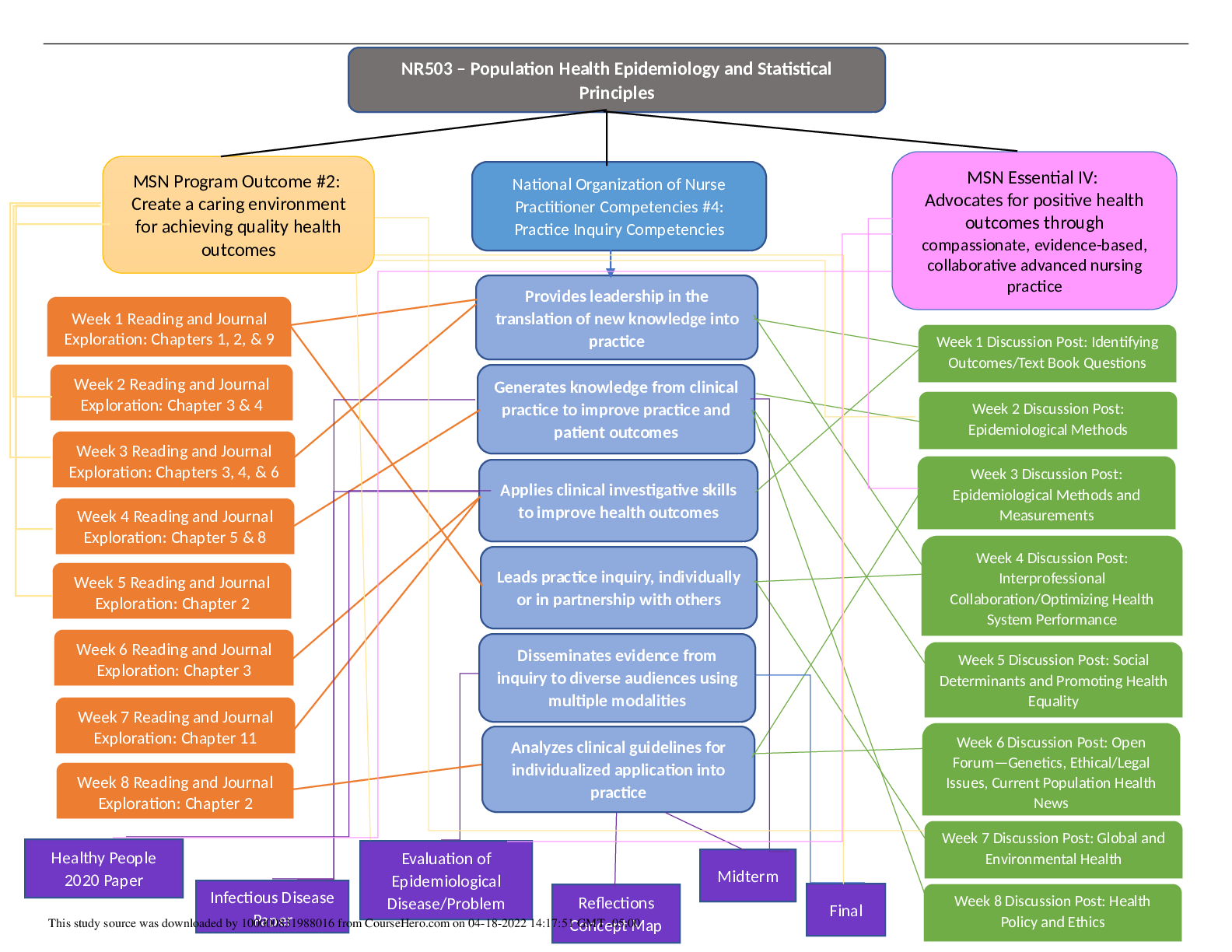

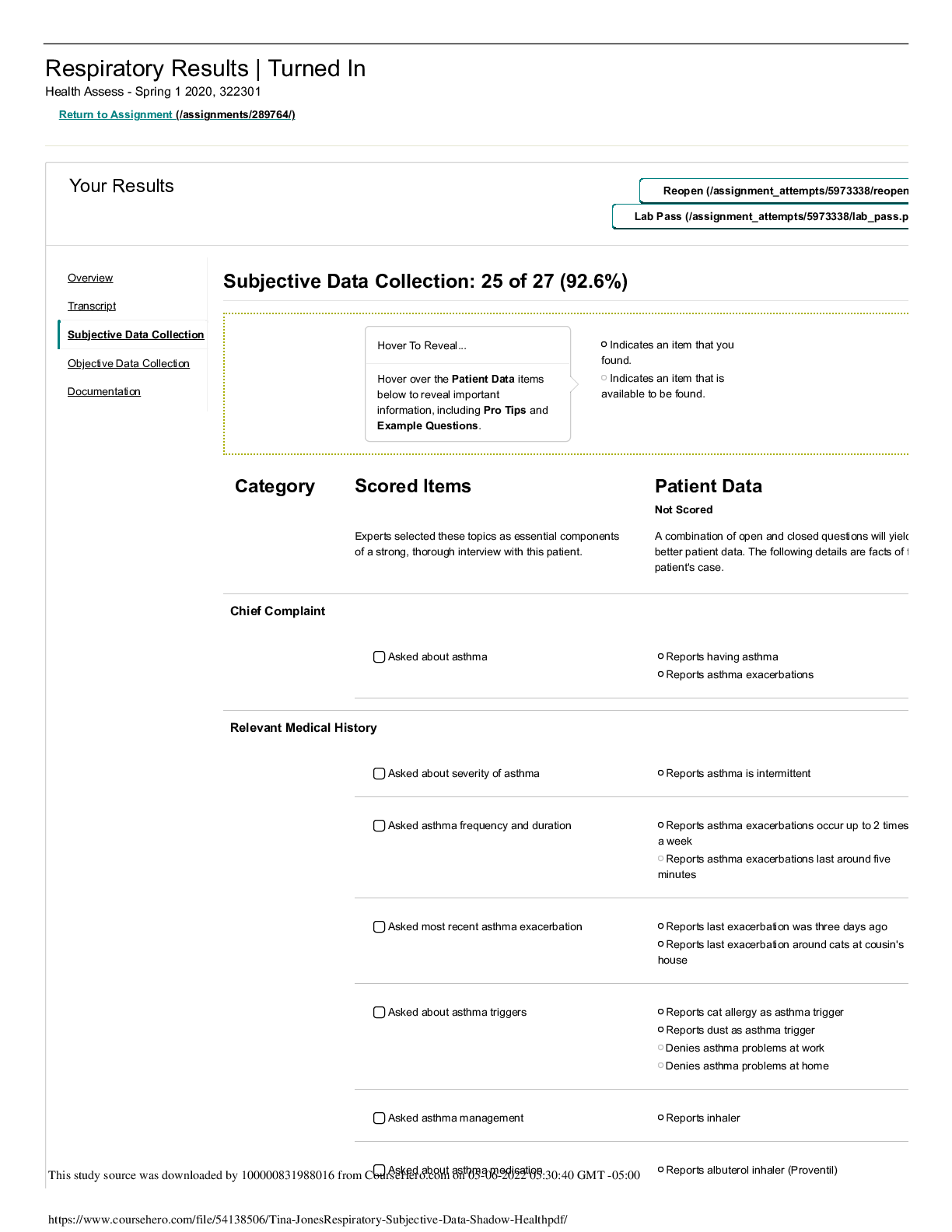
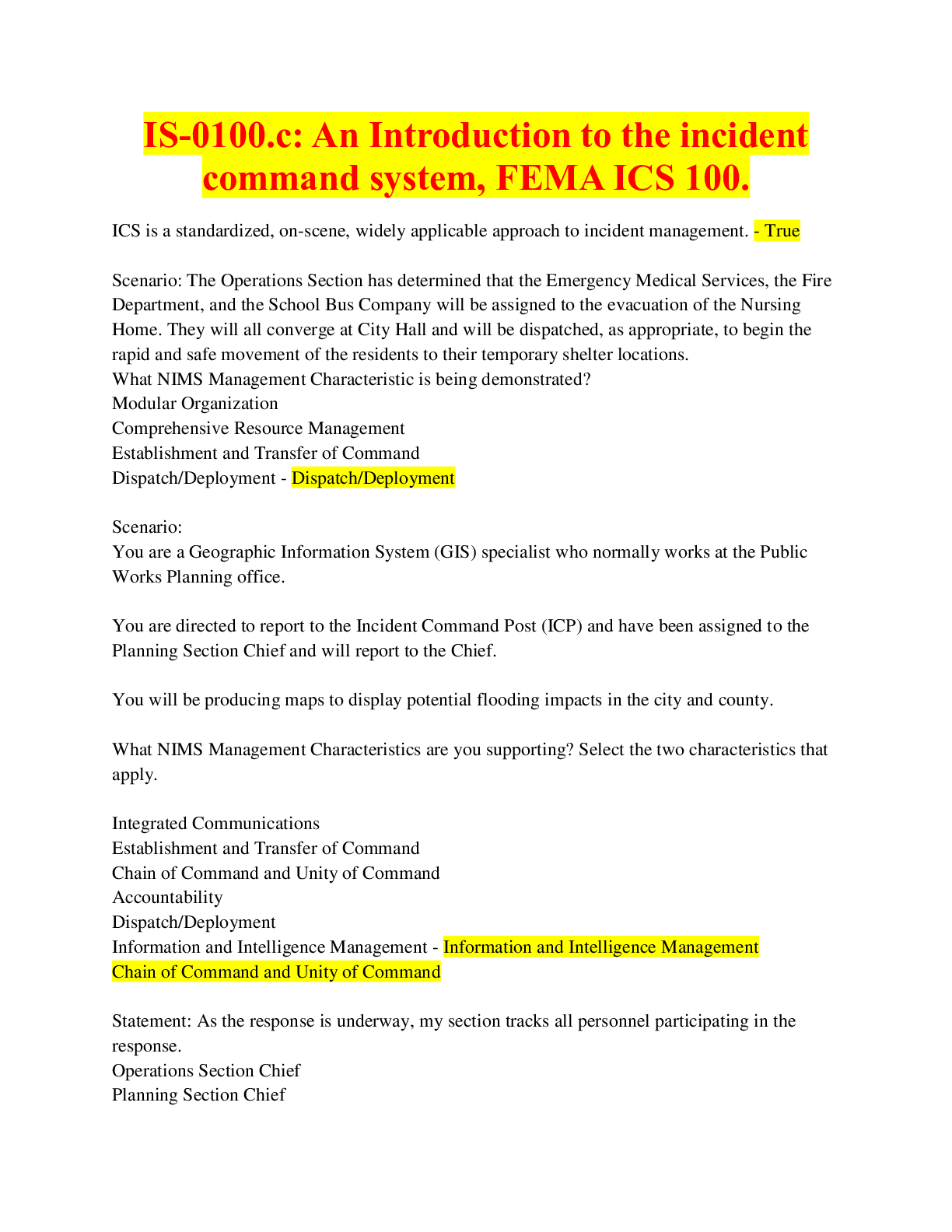



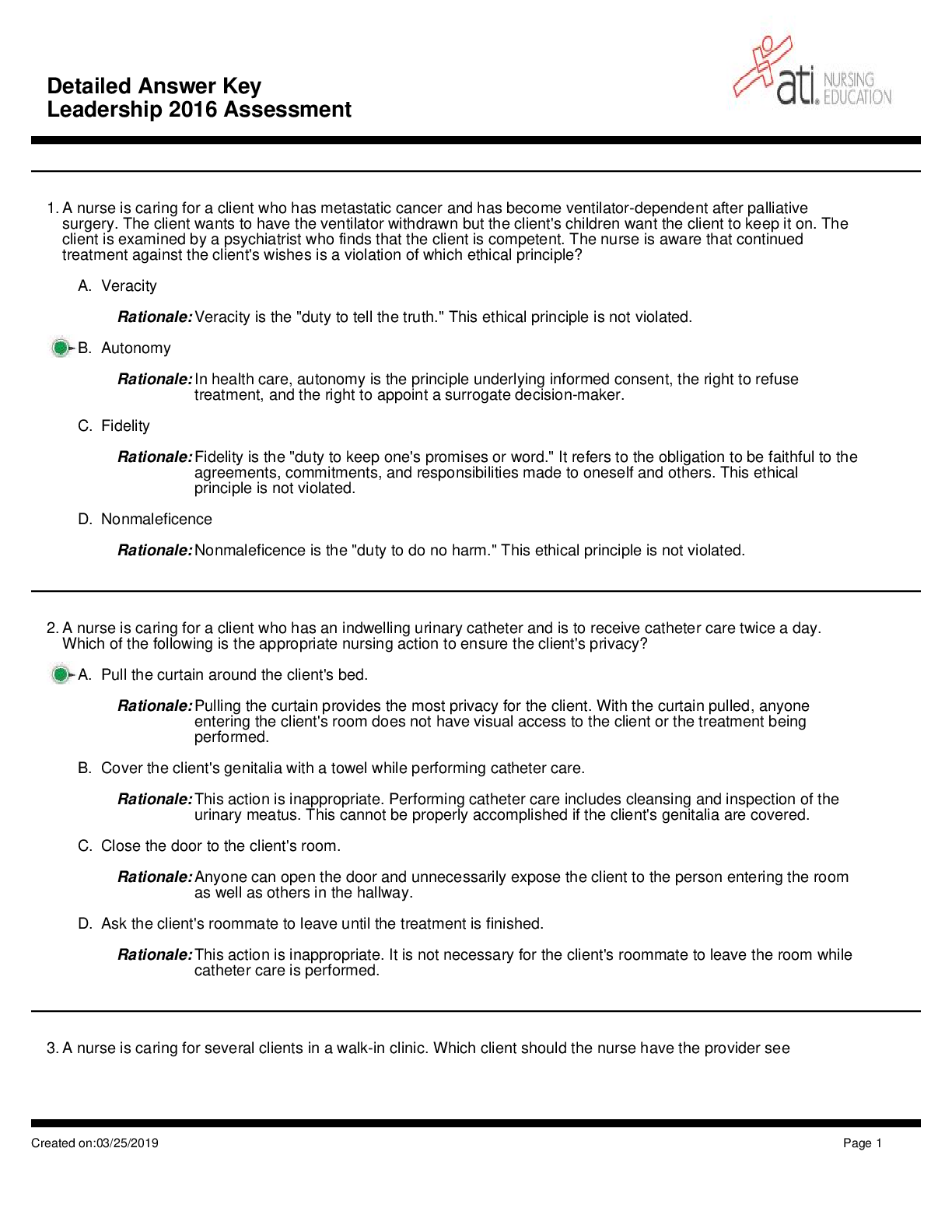
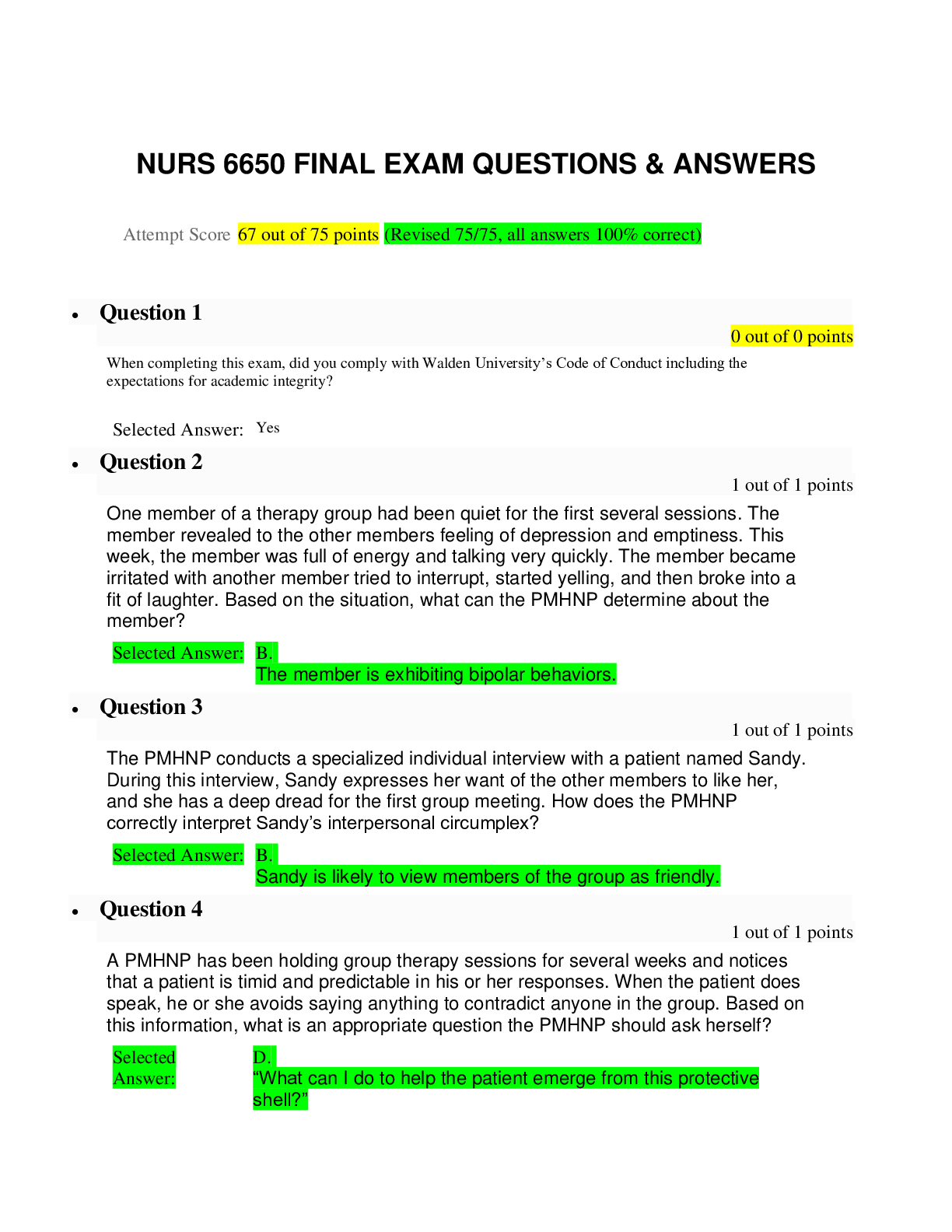
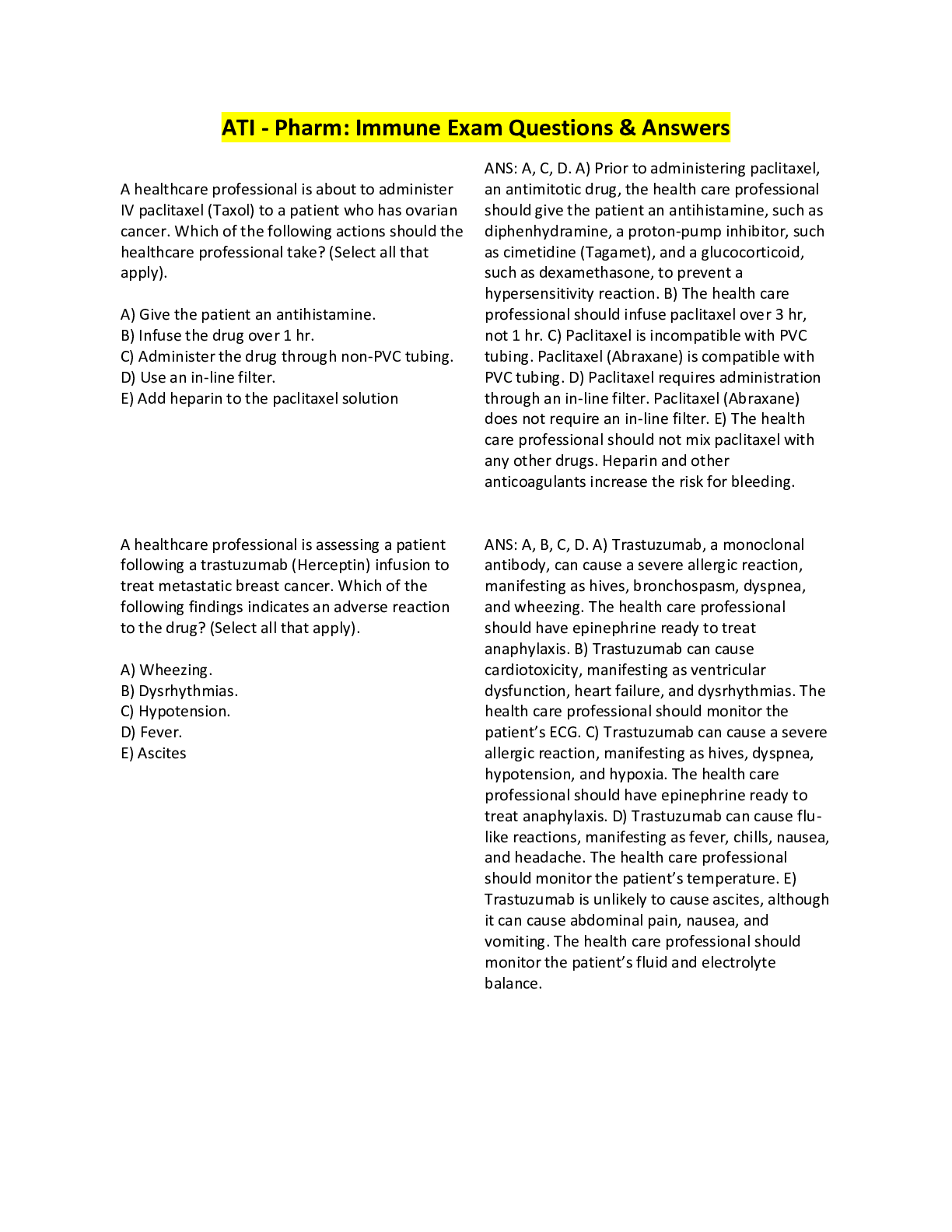
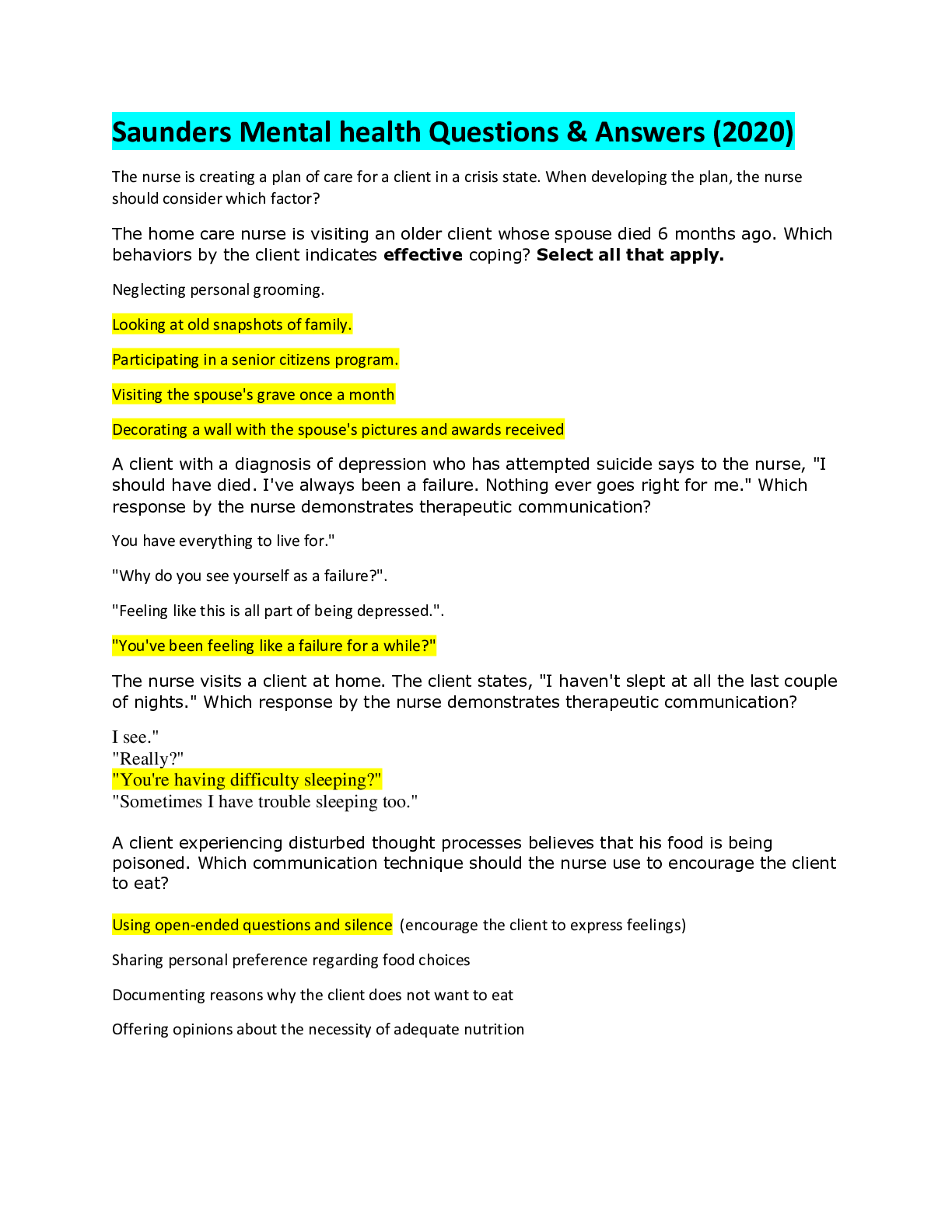
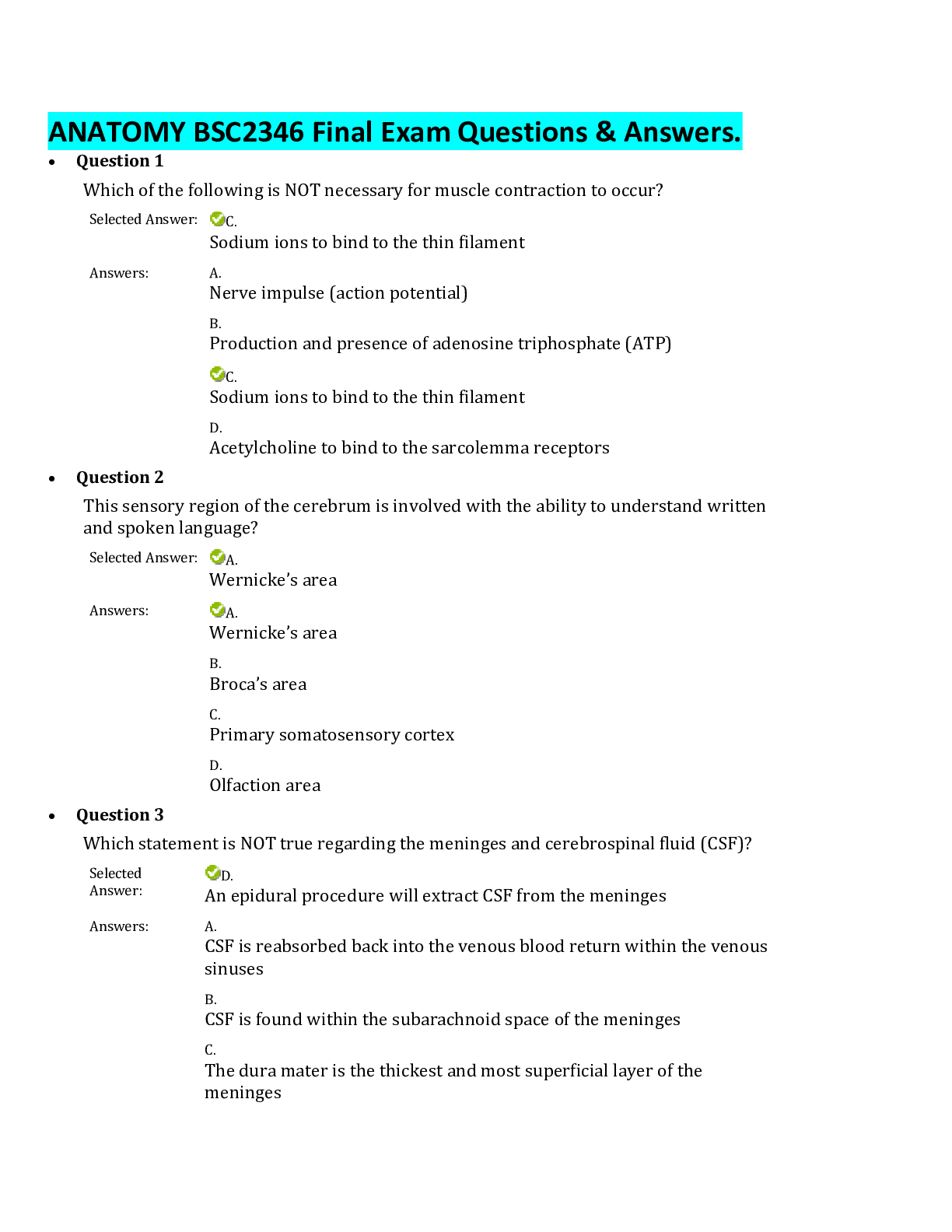

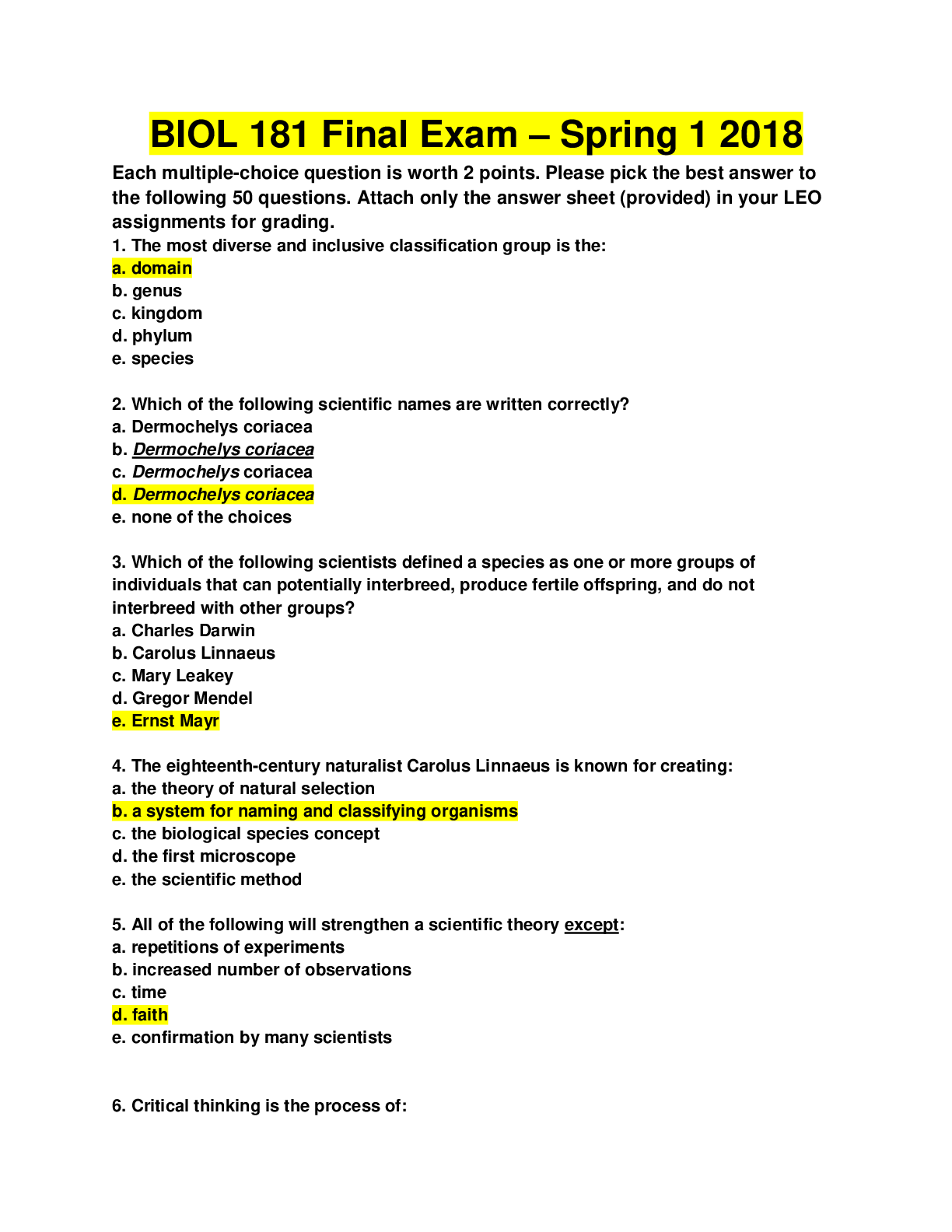
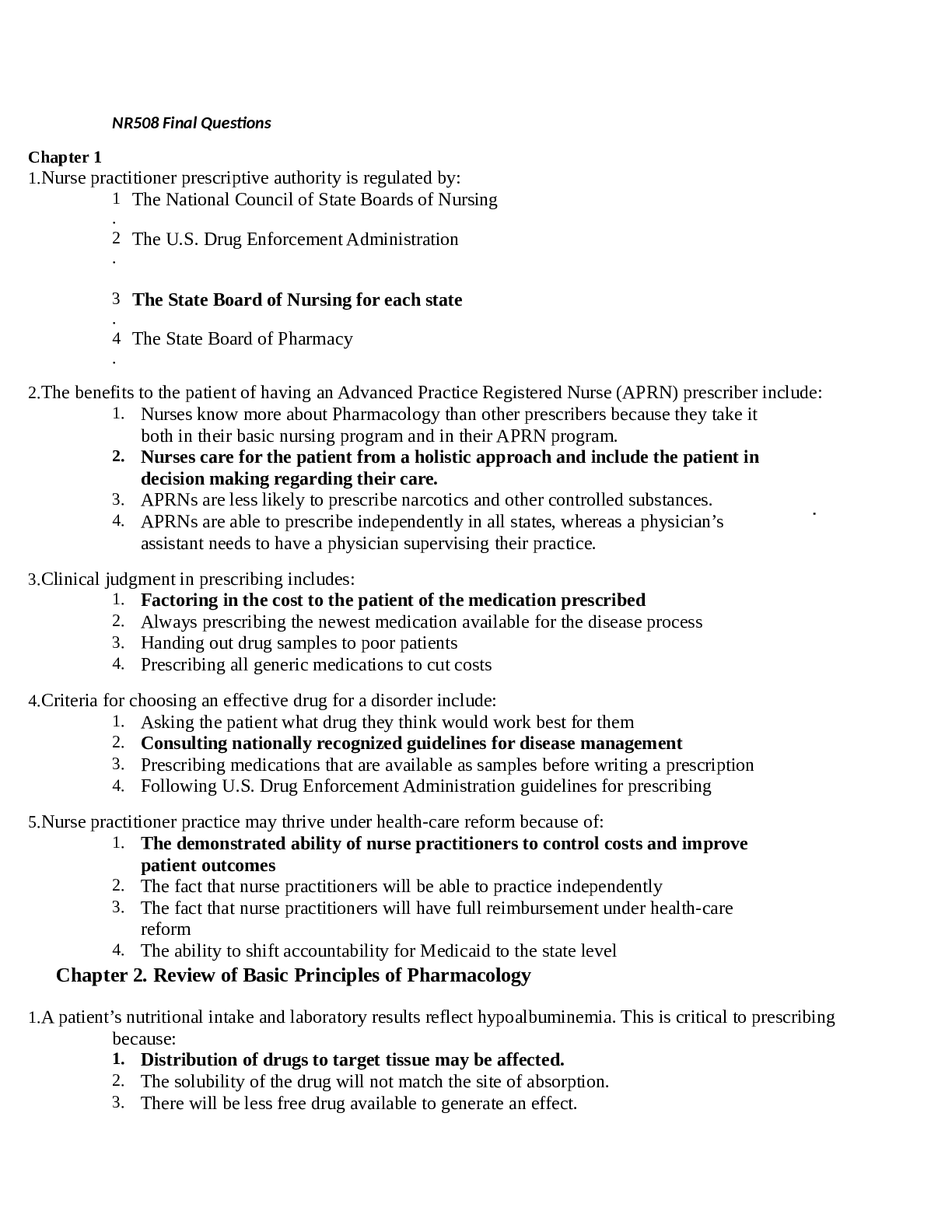

.png)

.png)

